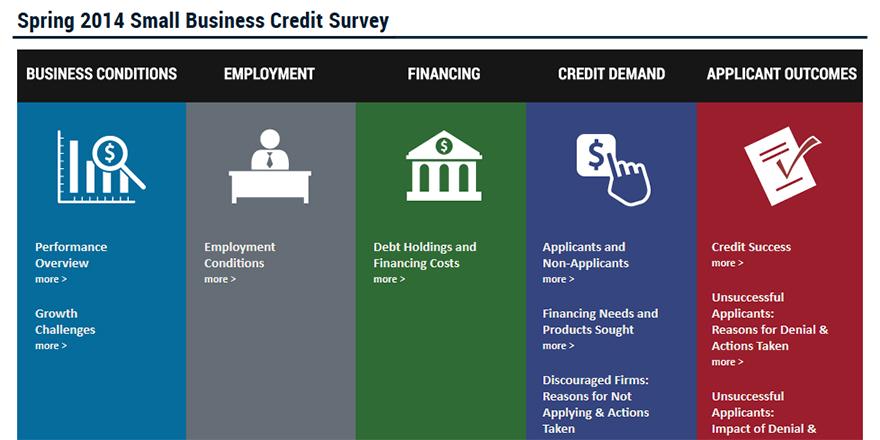
The New York Fed's Small Business Credit Survey (image via @NYFed_News)
Small businesses are critical to the jobs recovery. They employ half of private sector workers and have generated roughly two-thirds of the nation's net new jobs since 1995. Despite the economic significance of this sector, local policymakers lack high quality information about small firms' performance and their financing and investment decisions, including decisions to hire new workers. The New York Fed, working with a coalition of community partners, is trying to fill this gap.
Since 2010, the New York Fed's Outreach Team has surveyed small businesses in the greater New York region about their performance, financing needs and choices, and employment experiences. We work with organizations that serve the business community—including government agencies, chambers of commerce, and nonprofit service organizations—to gather timely intelligence and help shape programs that benefit small business owners.
Two themes have emerged from the survey: unmet small dollar credit needs (loans of $250k or less) and high credit application costs.
First, small business loans under $250k are the most frequently needed and hardest to come by. According to the latest Small Business Credit Survey (SBCS), 90% of small businesses in our region that applied for credit in 2013 sought amounts under $1 million, with the bulk of demand under $250k. These figures are consistent with national data, which show that small dollar lending through large and small banks hasn't returned to pre-recession levels.
Why do firms need small dollar loans? The most common need is working capital to finance day-to-day operations, including financing inventory for an outstanding contract or to smooth seasonal cash flow. However, approval rates for these smaller amount loans were significantly lower than those for higher dollar amounts. The most common credit challenges are weak performance, often resulting in a weak credit score, and insufficient collateral.
City and state officials at the Department of Small Business Services and Empire State Development have used these insights to shape industry-specific loan and grant programs and to design post-Superstorm Sandy recovery programs. Our team at the New York Fed has used the findings to shape Access to Capital workshops, which we hold regularly in New York, New Jersey, and Connecticut. The workshops demystify the credit application process by featuring direct conversations with lenders. They also introduce businesses that cannot qualify for traditional credit to alternative credit sources such as community development financial institutions, which can assume greater risk than banks and feature credit products designed to introduce (or reintroduce) firms into the financial mainstream.
A second and related finding from our research is that the credit search process can be quite costly in time and effort. Small business borrowers report spending more than 30 hours on average applying for loans—the better part of a workweek of a full-time employee. Consistent with this, small firms report growing interest in obtaining credit from non-traditional sources, including online lenders, which promise faster credit decisions. Even though this market currently represents less than $10 billion in outstanding loan capital, compared to the $700 billion from traditional sources, it is estimated that the portfolio balance of online lenders is doubling every year.
While the online sector has streamlined the credit application process, the terms and conditions can be quite costly. For example, online balance sheet lenders like OnDeck and Kabbage typically provide small short-term loans at an annualized rate that can range anywhere between 30 to 120 percent. Peer-to-peer lenders like Lending Club and Prosper, on the other hand, normally target near-prime borrowers and lend larger amounts for longer terms; interest rates for these loans range from 8 to 24 percent.
Given the importance of these trends for the economic health of small businesses and the US economy, the New York Fed remains committed to finding ways to maximize opportunities from credit innovations and minimize risk. Our goal is to provide high quality information and analysis on small businesses and to increase transparency about new sources of credit that may profoundly affect firms' financing options.
***
by Claire Kramer, AVP, Director of Community Development, and Diego Aragon, Associate Director, Outreach and Education
Find the New York Fed on Twitter @NYFed_News and on Facebook here.




